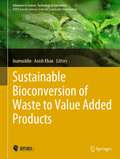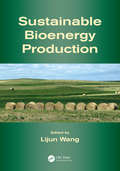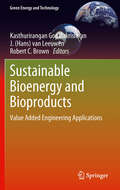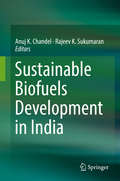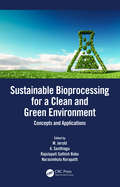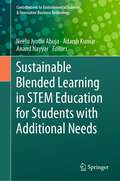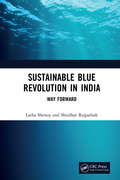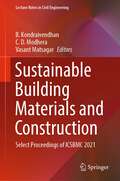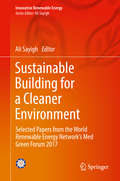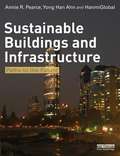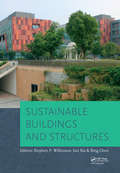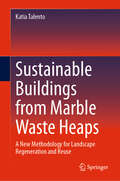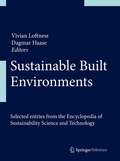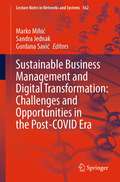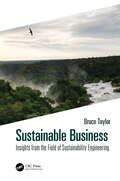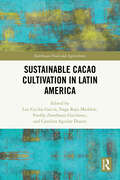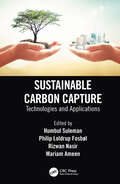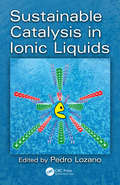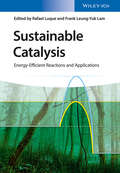- Table View
- List View
Sustainable Bioconversion of Waste to Value Added Products (Advances in Science, Technology & Innovation)
by Inamuddin Anish KhanThis edited book discusses various processes of feedstocks bioconversion such as bioconversion of food waste, human manure, industrial waste, beverage waste, kitchen waste, organic waste, fruit and vegetable, poultry waste, solid waste, agro-industrial waste, cow dung, steroid, lignocellulosic residue, biomass, natural gas etc. Nowadays, the industrial revolution and urbanization have made human life comfortable. However, this requires excess usage of natural resources starting from food and food products, to energy resources, materials as well as chemicals. The excess use of natural resources for human comfort is expected to high fuel prices, decline natural resources as well as cause a huge hike in the cost of raw materials. These factors are pushing researchers to grow environmentally friendly processes and techniques based on inexpensive and sustainable feedstock to accomplish such worldwide targets. Bioconversion, otherwise called biotransformation, is the change of natural materials, for example, plant or animal waste, into usable items or energy sources by microorganisms. Bioconversion is an environmentally friendly benevolent choice to supplant the well-established chemical procedures utilized these days for the production of chemicals and fuels. A variety of alternatives advancements are being considered and are directly accessible to acquire diverse valuable end-products through bioprocesses. This book discusses in detail the process and techniques of bioconversion by focusing on the organic feedstock of animal and plant origin. It brings solutions to the bioconversion of various feedstock into value-added products.
Sustainable Bioeconomy: Pathways to Sustainable Development Goals
by Ram Prasad Shachi Shah V. VenkatramananSustainable development is the most important challenge facing humanity in the 21st century. The global economic growth in the recent past has indeed exhibited marked progress in many countries. Nevertheless, the issues of income disparity, poverty, gender gaps, and malnutrition are not uncommon in the global landscape, in spite of the upward growth of the economy and technological advances. This grim picture is further exacerbated by our growing human population, unmindful resource use, ever-increasing consumption trends, and changing climate. In order to protect humanity and preserve the planet, the United Nations issued the “2030 agenda for sustainable development,” which includes but is not limited to sustainable production and consumption practices, e.g. in a sustainable bioeconomy. The hallmark of the sustainable bioeconomy is a paradigm shift from a fossil-fuel-based economy to a biological-based one, which is driven by the virtues of sustainability, efficient utilization of resources, and “circular economy.” As the sustainable bioeconomy is based on the efficient utilization of biological resources and societal transformations, it holds the immense potential to achieve the UN’s Sustainable Development Goals. This book shares valuable insights into the linkages between the sustainable bioeconomy and Sustainable Development Goals, making it an essential read for policymakers, researchers and students of environmental studies.
Sustainable Bioenergy Production
by Lijun WangGiven the environmental concerns and declining availability of fossil fuels, as well as the growing population worldwide, it is essential to move toward a sustainable bioenergy-based economy. However, it is also imperative to address sustainability in the bioenergy industry in order to avoid depleting necessary biomass resources. Sustainable Bioene
Sustainable Bioenergy Production - An Integrated Approach
by Martin Kappas Hans Ruppert Jens IbendorfThis book focuses primarily on the advantages and implications of sustainable bioenergy production in terms of ensuring a more sustainable world despite its growing energy demands. It addresses a new concept that focuses on the interactions between different uses of agricultural land (for example, agriculture for food, forage or energy and nature conservation) and their ecological, economic and societal impacts. This research concept provides new insights into the competition for resources and the synergies between different land uses. This book seeks to improve people's understanding of bioenergy's potentials for the future. It will be of interest not only to those involved in sustainable energy, but also to environmental planners, agriculture and soil specialists, and environmental policy-makers.
Sustainable Bioenergy and Bioproducts
by Robert C. Brown J. Hans Van Leeuwen Kasthurirangan GopalakrishnanSustainable Bioenergy and Bioproducts considers the recent technological innovations and emerging concepts in biobased energy production and coproducts utilization. Each chapter in this book has been carefully selected and contributed by experts in the field to provide a good understanding of the various challenges and opportunities associated with sustainable production of biofuel. Sustainable Bioenergy and Bioproducts covers a broad and detailed range of topics including: production capacity of hydrocarbons in the plant kingdom, algae, and microbes; biomass pretreatment for biofuel production; microbial fuel cells; sustainable use of biofuel co-products; bioeconomy and transportation infrastructure impacts and assessment of environmental risks and the life cycle of biofuels. Researchers, practitioners, undergraduate and graduate students engaged in the study of biorenewables, and members of the well-informed public will find Sustainable Bioenergy and Bioproducts to be a useful and comprehensive research tool, describing the state of the art and recent developments in this field.
Sustainable Biofuels Development in India
by Anuj K. Chandel Rajeev K. SukumaranThis book will provide assistance to the broad range of readers involved in the crude oil import and production; renewable energy production; biomass analysis and bioconversion; greenhouse gas emissions; techno-economic analysis and government policies for implementing biofuels in India. This book presents important aspects on the large scale production of biofuels following a bio-refinery concept and its commercialization and sustainability issues. Hence, it is a useful resource to policy makers, policy analysts, techno-economic analysts and business managers who deal with commercialization and implementation of bio-based energy and other value-added products. The following features of this book attribute its distinctiveness: As a first uniquely focused scientific and technical literature on bioenergy production in the context of India. To its coverage of technological updates on biomass collection, storage and use, biomass processing, microbial fermentation, catalysis, regeneration, solar energy and monitoring of renewable energy and recovery process. To the technical, policy analysis, climate change, geo-political analysis of bioenergy and green transportation fuels at industrial scale.
Sustainable Bioprocessing for a Clean and Green Environment: Concepts and Applications
by M. Jerold A. Santhiagu Rajulapati Sathish Babu Narasimhulu KorapattiSustainable Bioprocessing for a Clean and Green Environment: Concepts and Applications highlights the importance of waste to health in which waste is safely converted to value-added products via bioprocess technologies. Providing fundamental concepts and applications, this book also offers readers the methodology behind the operation of a variety of biological processes used in developing valuable products from waste. Features: Discusses synthesis and use of environmentally friendly biobased materials, such as biopolymer films and biobased plasticizers Highlights nanotechnology applications in the treatment of pollution and emphasizes the synthesis of biogenic nanomaterials for environmental remediation Describes the use of biosurfactants and emerging algal technologies, such as applications of microalgae in nutraceuticals and biofuel production Details delignification for lignocellulosic biomass This interdisciplinary book offers researchers and practitioners in chemical engineering, environmental engineering, and related fields a broad perspective on fundamentals, technologies, and environmental applications of sustainable bioprocessing.
Sustainable Biotechnology and Environmental Protection: A Four-pronged Strategy (Green Energy and Technology)
by Yelizaveta Chernysh Viktoriia Chubur Hynek RoubíkThis book explores the critical role of biotechnology in addressing today’s most pressing environmental challenges. The book presents a comprehensive four-pronged strategy focused on minimizing waste, reducing toxicity, improving waste disposal, and transforming waste into valuable resources. With a special emphasis on sustainable bioeconomy approaches, it highlights the potential of biotechnological innovations in urban development and environmental protection. The book also addresses the impact of policies and regulations, offering a holistic view of how biotechnology can pave the way for a safer and more sustainable future.
Sustainable Blended Learning in STEM Education for Students with Additional Needs (Contributions to Environmental Sciences & Innovative Business Technology)
by Anand Nayyar Adarsh Kumar Neelu Jyothi AhujaThis book comprehensively covers sustainable blended learning approach in each of the STEM (science, technology, engineering and mathematics) disciplines. The book also includes the compilation of detailed concepts of blended learning ranging from definition, need, features, models, advantages and disadvantages and comparisons with traditional face-to-face learning. Sustainable blended learning in K-12 education has an immense role as foundation to learning for students in their early education. Fostering creativity and inculcating problem solving and critical thinking skills are the integral aspect of STEM education, which encourages students to pursue them to for their future careers. This book presents recent practices taken by experts at various levels to promote education in STEM. Furthermore, impact over teacher–student relationships is analyzed. Lastly, sustainable frameworks, strategies and implementation to incorporate students with additional needs are explored.
Sustainable Blue Revolution in India: Way Forward
by Latha Shenoy Shridhar RajpathakThis book provides comprehensive information on several dimensions of blue revolution in a structured form. Material provided in the book has been gathered from several relevant published sources and views expressed are based on practical field experience of the authors. Blue revolution would be one of the big game changers for the Indian economy. The subject of sustainable development of fisheries sector being very vast, concerted efforts have been made to accommodate all the relevant elements. Very little reading material with proper analysis is currently available and this book is expected to bridge the gap and project way-forward to achieve sustainable development of fisheries and aquaculture in India under the blue revolution. The book is organised under 13 chapters covering wide ranging subjects that include fish production, processing, marketing, exports/imports of fishery products; ecolabelling; role of industry in promoting sustainability in fishing and aquaculture; sustainability issues in marine/inland fisheries/aquaculture; and fisheries regulations and legislations. Information has been provided on Sustainable Development Goals(SDGs) particularly SDG 14 (Life Below Water); components of blue economy; Government of India fisheries development initiatives; and executive summary of recently launched PMMSY. Emerging plant and cell-based seafood segment; overall impacts of climate change; and impact of recent pandemic COVID-19 on fisheries and aquaculture are discussed under separate chapters. Finally, a chapter on ‘Way Forward’ is included that suggests practical management measures, technology infusion, technical interventions along with few innovative concepts and approaches towards achieving blue revolution. Note: T&F does not sell or distribute the Hardback in India, Pakistan, Nepal, Bhutan, Bangladesh and Sri Lanka.
Sustainable Bridge Structures: Proceedings of the 8th New York City Bridge Conference, 24-25 August, 2015, New York City, USA
by Khaled M. MahmoudThe ever-increasing traffic demands, coupled with deteriorating condition of bridge structures, present great challenges for maintaining a healthy transportation network. The challenges encompass a wide range of economic, environmental, and social constraints that go beyond the technical boundaries of bridge engineering. Those constraints compound
Sustainable Building Materials and Construction: Select Proceedings of ICSBMC 2021 (Lecture Notes in Civil Engineering #222)
by Vasant Matsagar B. Kondraivendhan C. D. ModheraThis book presents the select proceedings of the International Conference on Sustainable Building Materials and Construction (ICSBMC 2021), and examines a range of durable, energy-efficient, advance construction and building materials produced from industrial wastes and byproducts. The topics covered include advanced construction materials, durability of concrete structures, waste utilization, repair & rehabilitation of concrete structures, structural analysis & design, composites, nanomaterials and smart materials in seismic engineering. The book also discusses various properties and performance attributes of modern-age concretes including their strength, durability, workability, and carbon footprint. This book will be a precious reference for beginners, researchers, and professionals interested in sustainable construction and allied fields.
Sustainable Building and Structures: Proceedings of the 2nd International Conference in Sutainable Buildings and Structures (ICSBS 2019), October 25-27, 2019, Suzhou, China
by Konstantinos Papadikis Chee S. Chin Isaac Galobardes Guobin Gong Fangyu GuoSustainable Buildings and Structures: Building a Sustainable Tomorrow collects the contributions presented at the 2nd International Conference on Sustainable Buildings and Structures (Suzhou, China, 25-27 October 2019). The papers aim at sharing the state-of-the-art on sustainable approaches to engineering design and construction, and cover a wide range of topics: Sustainable Construction Materials Sustainable Design in Built EnvironmentGreen and Low Carbon BuildingsSmart Construction and Construction Management Sustainable Buildings and Structures: Building a Sustainable Tomorrow will be of interest to academics, professionals, industry representatives and local government officials involved in civil engineering, architecture, urban planning, structural engineering, construction management and other relate fields.
Sustainable Building for a Cleaner Environment: Selected Papers from the World Renewable Energy Network's Med Green Forum 2017 (Innovative Renewable Energy)
by Ali SayighThis book contains selected papers presented during the bi-annual World Renewable Energy Network’s Med Green Forum aimed at the international community as well as Mediterranean countries. This forum highlights the importance of growing renewable energy applications in two main sectors: Electricity Generation and the Sustainable Building Sector. In-depth chapters highlight the most current research and technological breakthroughs, covering a broad range of renewable energy technologies and applications in all sectors – for electricity production, heating and cooling, agricultural applications, water desalination, industrial applications and for the transport sectors.
Sustainable Buildings and Infrastructure: Paths to the Future
by Annie Pearce Ltd Hanmiglobal Co Yong Han AhnConstruction is one of the biggest industries in the world, providing necessary facilities for human prosperity ranging from the homes in which we live to the highways we drive, the power plants that provide energy for our daily activities, and the very infrastructure on which human society is built. The construction sector, including the building sector, has among the largest potential of any industry to contribute to the reduction of greenhouse gas emissions. This ambitious and comprehensive textbook covers the concept of embedding sustainability across all construction activities. It is aimed at students taking courses in construction management and the built environment. Written in a lively and engaging style the book sets out the practical requirements of making the transition to a sustainable construction industry by 2020. Case studies are included throughout making the book both a core reference and a practical guide.
Sustainable Buildings and Structures: Proceedings of the 1st International Conference on Sustainable Buildings and Structures (Suzhou, P.R. China, 29 October - 1 November 2015)
by Bing Chen Jun Xia Stephen P. WilkinsonSustainable Buildings and Structures collects the contributions presented at the 1st International Conference on Sustainable Buildings and Structures (Suzhou, China, 29 October-1 November 2016). The book aims to share thoughts and ideas on sustainable approaches to urban planning, engineering design and construction. The topics discussed include:-
Sustainable Buildings from Marble Waste Heaps: A New Methodology for Landscape Regeneration and Reuse
by Katia TalentoThis book examines how discarded marble heaps can be repurposed, in situ, to breathe new life into the landscape, offering solutions that are as innovative as they are practical and sustainable. The author showcases the power of creativity and sustainability to revitalize communities and landscapes with new architectural buildings and public spaces. The volume combines theory with practice, including an extensive bibliography about landscape mutation, rehabilitation of quarries and waste reuse, and, at the same time, a detailed case study on the Estremoz Anticline, in Portugal, one of the world’s main sites of marble extraction. Of all the material extracted from the several quarries of the Estremoz Anticline, only about 9% is marketed because of assessed of quality standards. Distinct from other research volumes in this domain, “Sustainable Buildings from Marble Waste Heaps” focuses on the regeneration of industrial landscapes through the on-site reuse of waste heaps, without removing the material from the context it belongs to or changing its morphology, preserving the identity of the place and promoting circular economy.
Sustainable Built Environment: Select Proceedings of ICSBE 2023 (Lecture Notes in Civil Engineering #451)
by Thayaparan Gajendran Deepak Bajaj Sanjay PatilThis book presents the select proceedings of International Conference on Sustainable Built Environment (ICSBE 2023). It discusses the issues of sustainability and resilience in all types of building projects, construction projects, operational building, and infrastructure projects within urban regions of the world. The key themes covered in this book are sustainable urban planning, sustainable construction, real estate, housing, net-zero built environment, climate change policy, legal framework, climate finance, technology, and innovation toward decarbonization of the built environment. This book is useful for researchers and professionals working in the fields of construction management, built environment, and allied fields.
Sustainable Built Environments
by Vivian Loftness Dagmar HaaseSustainable design is a collective process whereby the built environment achieves unprecedented levels of ecological balance through new and retrofit construction, with the goal of long-term viability and humanization of architecture. Focusing on the environmental context, sustainable design merges the natural, minimum resource conditioning solutions of the past (daylight, solar heat, and natural ventilation) with the innovative technologies of the present. The desired result is an integrated "intelligent" system that supports individual control with expert negotiation for resource consciousness. International experts in the field address the fundamental questions of sustainable design and landscape management: How should the sustainability of landscapes and buildings be evaluated? Which targets have to be set and which thresholds should not be exceeded? What forms of planning and governance structures exist and to what extent do they further the goals of sustainability? Gathering 30 peer-reviewed entries from the Encyclopedia of Sustainability Science and Technology, Sustainable Built Environments provides comprehensive, multidisciplinary coverage of these issues and other aspects of sustainable building and landscape design.
Sustainable Business Management and Digital Transformation: Challenges and Opportunities in the Post-COVID Era (Lecture Notes in Networks and Systems #562)
by Marko Mihić Sandra Jednak Gordana SavićThis book covers high-quality peer-reviewed research papers presented at the 18th International Symposium of Organizational Sciences (SymOrg 2022) held in Belgrade, Serbia, from 11 to 14 June 2022. The aim of the book is providing stimulative framework for readers to explore viable alternatives and indicate implications for the post-pandemic world. Researchers from academia and industry present their original work focusing on different aspects of sustainable management and digital transformation including blockchain technology, business analytics, e-business, innovation, digital operations and logistics management, financial industry, public administration, lean business systems, digital transformation projects, human resources, marketing and communication, and quality and standardization. The chapters could be useful for industry experts, research institutions, universities, and all others who share a common interest in contemporary organizational sciences.
Sustainable Business: Insights from the Field of Sustainability Engineering
by Bruce TaylorEngineers have applied science to land people on the moon, design the cars we drive, and cram the power of a 20th-century supercomputer into the phones we carry. But what can happen when engineering’s systemic problem-solving skills are applied to improving the sustainability of business?This book stands on the shoulders of sustainability engineering insights to supplement business, engineering, and environmental curricula with tools necessary to effectively and efficiently improve the sustainability of organizations. Cutting through the clutter of terminology and approaches, this book uses case studies to outline a proven path to profitably secure “net zero” for facilities and their supply chains. And rather than stopping at the uninspiring target of “doing no harm,” it further empowers businesses and other organizations to create additional economic, environmental, and social benefits.This book: Offers numerous case studies from the Space Shuttle through the world’s first carbon neutral major food company to appropriate technology for safe water in developing countries to illustrate how to reduce environmental footprints while increasing profit margin and business value Explores redemptive entrepreneurship through the lens of the author’s founding of an award-winning engineering firm Presents strategies to strengthen the curricula of engineering, business, accounting, and procurement programs by uncovering significant sources of untapped value in conventional teaching
Sustainable Cacao Cultivation in Latin America (Earthscan Food and Agriculture)
by Naga Raju Maddela Luz Cecilia García Freddy Zambrano Gavilanes Carolina Aguilar DuarteThis book examines cacao cultivation with a view to improving the sustainable management and production of this crop.Theobroma cacao is an important species originating in the Ecuadorian Amazon and its product chocolate is consumed worldwide. Cacao cultivation is an industry supporting over ten million people, and so it is vitally important, in this changing climate, that the species is properly and sustainably managed and cultivated. This book brings together a wide range of experts from across the globe to examine cacao cultivation, from the basic aspects of reproduction, genetic improvement, nutrition and pest management, to agroforestry, industrialization and marketing in a global food system. Case studies are drawn from across Latin America, but the research reflects the nature of a crop that is cultivated in over 60 countries and processed, manufactured and consumed worldwide.This book will be of great interest to students and scholars of agronomy, sustainable agriculture, and crop science.
Sustainable Carbon Capture: Technologies and Applications
by Humbul Suleman Philip Loldrup Fosbøl Rizwan Nasir Mariam AmeenA comprehensive resource on different aspects of sustainable carbon capture technologies including recent process developments, environmentally friendly methods, and roadmaps for implementations. It discusses also the socio-economic and policy aspects of carbon capture and the challenges, opportunities, and incentives for change with a focus on industry, policy, and governmental sector. Through applications in various fields of environmental health, and four selected case studies from four different practical regimes of carbon capture, the book provides guidelines for sustainable and responsible carbon capture and addresses current and future global energy, environment, and climate concerns.
Sustainable Catalysis in Ionic Liquids
by Pedro LozanoSustainable Catalysis in Ionic Liquids provides an up-to-date overview of the relatively underexplored area of the use of room temperature ionic liquids as organocatalysts for a range of organic reactions, including polymerizations. Using organic molecules to promote reactions is an attractive option as these organic molecules can be safer than metal-based options. However, it is still important to be able to recycle and reuse these organic promoters. Ionic liquids provide this opportunity.
Sustainable Catalysis: Energy-Efficient Reactions and Applications
by Rafael Luque Frank Leung-Yuk LamHighlighting sustainable catalytic processes in synthetic organic chemistry, this useful guide places special emphasis on catalytic reactions carried out at room temperature. It describes the fundamentals, summarizes key advances, and covers applications in the field of organic synthesis, biomass conversion, and pollution control. Throughout, the latest research from various disciplines is combined, such as homogeneous and heterogeneous catalysis, biocatalysis, and photocatalysis. The book concludes with a chapter on future trends and energy challenges for the latter half of the 21st century and two case studies. With its multidisciplinary approach this is an essential reference for academic and industrial researchers in catalysis science aiming to design more sustainable and energy-efficient processes.
